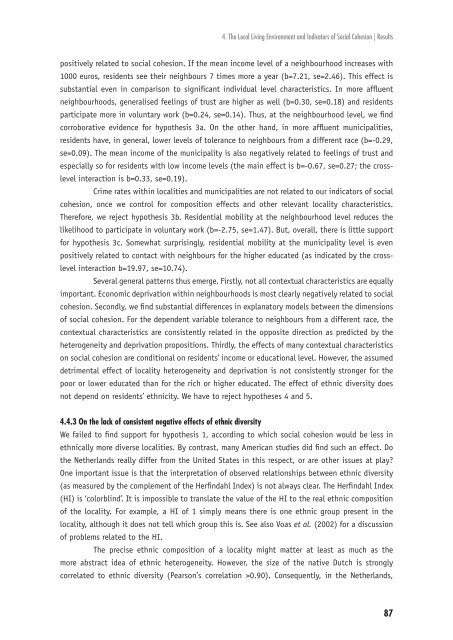Ethnic Hostility among Ethnic Majority and Minority Groups
Ethnic Hostility among Ethnic Majority and Minority Groups
Ethnic Hostility among Ethnic Majority and Minority Groups
Create successful ePaper yourself
Turn your PDF publications into a flip-book with our unique Google optimized e-Paper software.
4. The Local Living Environment <strong>and</strong> Indicators of Social Cohesion | Results<br />
positively related to social cohesion. If the mean income level of a neighbourhood increases with<br />
1000 euros, residents see their neighbours 7 times more a year (b=7.21, se=2.46). This effect is<br />
substantial even in comparison to signifi cant individual level characteristics. In more affl uent<br />
neighbourhoods, generalised feelings of trust are higher as well (b=0.30, se=0.18) <strong>and</strong> residents<br />
participate more in voluntary work (b=0.24, se=0.14). Thus, at the neighbourhood level, we fi nd<br />
corroborative evidence for hypothesis 3a. On the other h<strong>and</strong>, in more affl uent municipalities,<br />
residents have, in general, lower levels of tolerance to neighbours from a different race (b=-0.29,<br />
se=0.09). The mean income of the municipality is also negatively related to feelings of trust <strong>and</strong><br />
especially so for residents with low income levels (the main effect is b=-0.67, se=0.27; the crosslevel<br />
interaction is b=0.33, se=0.19).<br />
Crime rates within localities <strong>and</strong> municipalities are not related to our indicators of social<br />
cohesion, once we control for composition effects <strong>and</strong> other relevant locality characteristics.<br />
Therefore, we reject hypothesis 3b. Residential mobility at the neighbourhood level reduces the<br />
likelihood to participate in voluntary work (b=-2.75, se=1.47). But, overall, there is little support<br />
for hypothesis 3c. Somewhat surprisingly, residential mobility at the municipality level is even<br />
positively related to contact with neighbours for the higher educated (as indicated by the crosslevel<br />
interaction b=19.97, se=10.74).<br />
Several general patterns thus emerge. Firstly, not all contextual characteristics are equally<br />
important. Economic deprivation within neighbourhoods is most clearly negatively related to social<br />
cohesion. Secondly, we fi nd substantial differences in explanatory models between the dimensions<br />
of social cohesion. For the dependent variable tolerance to neighbours from a different race, the<br />
contextual characteristics are consistently related in the opposite direction as predicted by the<br />
heterogeneity <strong>and</strong> deprivation propositions. Thirdly, the effects of many contextual characteristics<br />
on social cohesion are conditional on residents’ income or educational level. However, the assumed<br />
detrimental effect of locality heterogeneity <strong>and</strong> deprivation is not consistently stronger for the<br />
poor or lower educated than for the rich or higher educated. The effect of ethnic diversity does<br />
not depend on residents’ ethnicity. We have to reject hypotheses 4 <strong>and</strong> 5.<br />
4.4.3 On the lack of consistent negative effects of ethnic diversity<br />
We failed to fi nd support for hypothesis 1, according to which social cohesion would be less in<br />
ethnically more diverse localities. By contrast, many American studies did fi nd such an effect. Do<br />
the Netherl<strong>and</strong>s really differ from the United States in this respect, or are other issues at play?<br />
One important issue is that the interpretation of observed relationships between ethnic diversity<br />
(as measured by the complement of the Herfi ndahl Index) is not always clear. The Herfi ndahl Index<br />
(HI) is ‘colorblind’. It is impossible to translate the value of the HI to the real ethnic composition<br />
of the locality. For example, a HI of 1 simply means there is one ethnic group present in the<br />
locality, although it does not tell which group this is. See also Voas et al. (2002) for a discussion<br />
of problems related to the HI.<br />
The precise ethnic composition of a locality might matter at least as much as the<br />
more abstract idea of ethnic heterogeneity. However, the size of the native Dutch is strongly<br />
correlated to ethnic diversity (Pearson’s correlation >0.90). Consequently, in the Netherl<strong>and</strong>s,<br />
87












